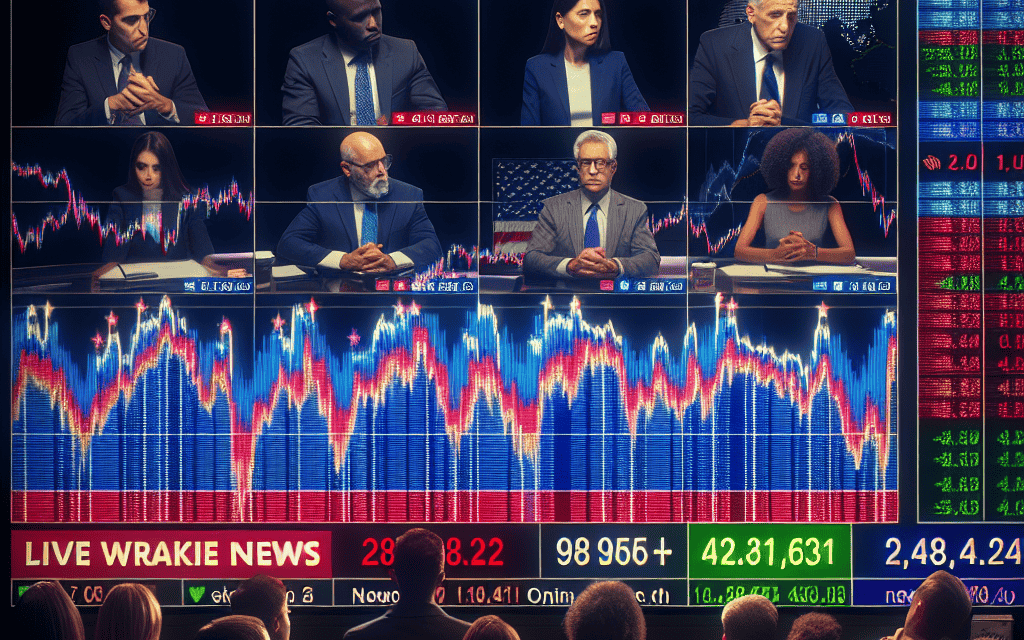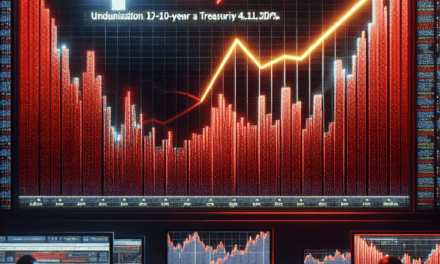“Real-Time Election Insights: Navigating Market Waves”
Introduction
Live Election Night: Stock Market Updates and Impacts provides real-time insights into how electoral outcomes influence financial markets. As votes are tallied and results unfold, investors and analysts closely monitor shifts in stock prices, currency valuations, and market indices. This dynamic event captures the intersection of politics and economics, highlighting investor sentiment and market volatility. Understanding these impacts is crucial for stakeholders aiming to navigate the financial landscape during this pivotal time.
Analyzing Stock Market Volatility During Election Night
As election night unfolds, the stock market often becomes a focal point for investors and analysts alike, eager to understand how the results might influence financial markets. Historically, election nights have been characterized by heightened volatility, as market participants react to the incoming results and attempt to predict the future economic policies of the winning candidates. This volatility is driven by uncertainty, a key factor that influences investor behavior. As the night progresses and more information becomes available, the market’s response can provide valuable insights into investor sentiment and expectations.
During election night, stock market volatility is primarily fueled by the anticipation of policy changes that could impact various sectors differently. For instance, a candidate with a platform focused on increasing infrastructure spending might boost stocks in construction and materials, while another candidate advocating for stricter regulations on certain industries could lead to declines in those sectors. Consequently, investors closely monitor the election results to adjust their portfolios in anticipation of these potential policy shifts. This dynamic creates a unique environment where market movements are not solely based on economic fundamentals but are also heavily influenced by political developments.
Moreover, the global nature of financial markets means that election night in one country can have ripple effects across the world. International investors, who may have significant stakes in the domestic market, also react to the election outcomes, further contributing to the volatility. The interconnectedness of global markets means that a significant political event in one country can lead to fluctuations in foreign exchange rates, commodity prices, and international stock indices. As a result, election night becomes a global event, with investors from different time zones staying alert to the unfolding developments.
In addition to the immediate reactions on election night, the stock market’s response can also provide insights into longer-term trends. For example, if a particular sector experiences a significant rally or decline, it may indicate investor expectations about the future regulatory or economic environment under the new administration. These movements can serve as early indicators of how the market perceives the potential impact of the election results on economic growth, inflation, and interest rates. Consequently, analysts and investors pay close attention to these trends to inform their investment strategies in the weeks and months following the election.
Furthermore, it is important to consider the role of technology and media in shaping market reactions during election night. With the advent of real-time data and news dissemination, investors have access to a constant stream of information, allowing them to make rapid decisions. Social media platforms and financial news outlets play a crucial role in disseminating election updates, influencing investor sentiment, and potentially amplifying market volatility. This instantaneous access to information can lead to swift market movements, as investors react to both verified results and speculative reports.
In conclusion, election night represents a period of heightened stock market volatility, driven by the uncertainty surrounding potential policy changes and their impact on various sectors. The global nature of financial markets means that these events have far-reaching implications, influencing investor behavior worldwide. By analyzing the market’s response during election night, investors and analysts can gain valuable insights into future economic trends and adjust their strategies accordingly. As technology continues to evolve, the speed and accessibility of information will likely play an increasingly significant role in shaping market reactions during these pivotal moments.
Key Sectors to Watch on Election Night
As election night unfolds, the stock market becomes a focal point for investors and analysts alike, eager to gauge the immediate impacts of electoral outcomes on various sectors. The anticipation surrounding election results often leads to heightened market volatility, with key sectors experiencing significant fluctuations based on the perceived implications of policy shifts. Understanding which sectors are most likely to be affected can provide valuable insights for investors looking to navigate the complexities of election night trading.
To begin with, the energy sector is traditionally one of the most sensitive to election outcomes. This sensitivity stems from the stark policy differences between political parties regarding energy production and environmental regulations. For instance, a government favoring renewable energy initiatives could lead to a surge in stocks related to solar, wind, and other clean energy technologies. Conversely, a leadership that prioritizes fossil fuel development might bolster oil and gas companies. As election results start to trickle in, investors will closely monitor any indications of policy direction that could impact energy sector profitability.
In addition to energy, the healthcare sector is another area where election results can have profound effects. Healthcare policies, including those related to insurance coverage, drug pricing, and regulatory approvals, are often central to political platforms. A government that advocates for expanded healthcare access and stricter drug pricing controls could pressure pharmaceutical and insurance companies. On the other hand, a more market-driven approach might benefit these industries by reducing regulatory burdens. Consequently, healthcare stocks are likely to experience volatility as investors react to the potential for policy changes that could reshape the sector’s landscape.
Moreover, the financial sector is poised to react to election night developments, particularly in relation to regulatory and tax policies. Financial institutions, including banks and investment firms, are highly sensitive to changes in regulations that affect lending practices, capital requirements, and consumer protections. A government inclined towards deregulation could boost financial stocks by creating a more favorable operating environment. Conversely, increased regulatory scrutiny might weigh on the sector. Additionally, tax policy changes can influence corporate profitability and investment strategies, further impacting financial markets.
Furthermore, the technology sector, a significant driver of economic growth, is not immune to election night impacts. Issues such as data privacy, antitrust regulations, and international trade policies are critical to technology companies. A government that prioritizes stringent data protection laws or aggressive antitrust actions could pose challenges for tech giants. Conversely, policies that promote innovation and global trade might enhance the sector’s growth prospects. As such, investors will be keenly attuned to any election outcomes that signal shifts in the regulatory environment for technology firms.
Lastly, the defense sector often experiences fluctuations based on election results, given the varying approaches to national security and defense spending. A government committed to increasing defense budgets could lead to a rally in defense stocks, while a focus on diplomatic solutions and reduced military expenditures might have the opposite effect. As election night progresses, investors will assess the potential for changes in defense policy and their implications for defense contractors and related industries.
In conclusion, election night is a critical juncture for the stock market, with key sectors such as energy, healthcare, financials, technology, and defense poised to react to the unfolding political landscape. By closely monitoring election results and their potential policy implications, investors can better position themselves to navigate the market’s volatility and capitalize on emerging opportunities. As the night progresses, the interplay between political developments and market dynamics will undoubtedly shape the investment landscape in the days and weeks to come.
Historical Election Night Market Trends
Throughout history, election nights have been pivotal not only for the political landscape but also for financial markets. Investors keenly observe these events, as the outcomes can significantly influence market dynamics. Historically, election nights have been characterized by heightened volatility, with stock markets reacting swiftly to the unfolding results. This phenomenon is rooted in the uncertainty that elections inherently bring, as market participants attempt to anticipate the economic policies of the incoming administration.
To understand the historical trends of election night market behavior, it is essential to consider the broader context of each election. For instance, during the 2008 U.S. presidential election, the financial markets were already in turmoil due to the global financial crisis. The election of Barack Obama was met with cautious optimism, as investors hoped for policies that would stabilize the economy. On election night, the markets experienced fluctuations, but the overall trend was one of gradual recovery as the new administration’s policies began to take shape.
In contrast, the 2016 U.S. presidential election presented a different scenario. The unexpected victory of Donald Trump led to immediate market reactions, with futures markets initially plummeting. However, as investors digested the potential implications of Trump’s pro-business policies, the markets rebounded sharply. This rapid shift highlighted the market’s sensitivity to perceived policy changes and the importance of investor sentiment in driving market movements.
Moreover, the 2020 U.S. presidential election further underscored the complexity of election night market trends. The election took place amid the COVID-19 pandemic, adding an additional layer of uncertainty. As results trickled in, markets experienced significant volatility, reflecting the uncertainty surrounding the pandemic’s economic impact and the anticipated policy responses. Ultimately, the election of Joe Biden was met with a positive market response, as investors anticipated a more predictable policy environment and substantial fiscal stimulus.
These historical examples illustrate that while each election night is unique, certain patterns tend to emerge. Markets often react to the perceived economic implications of the election outcome, with sectors expected to benefit from the winning candidate’s policies experiencing gains, while those anticipated to face challenges may see declines. Additionally, the level of uncertainty surrounding the election can amplify market volatility, as investors grapple with the potential for policy shifts.
Furthermore, it is important to recognize that election night market trends are not solely driven by domestic factors. Global markets are interconnected, and international investors closely monitor U.S. elections due to their potential impact on global economic conditions. Consequently, election night market reactions can reverberate across the globe, influencing markets far beyond U.S. borders.
In conclusion, historical election night market trends reveal a complex interplay of factors that drive market behavior. While each election presents its own set of circumstances, common themes such as uncertainty, investor sentiment, and policy expectations consistently shape market reactions. As investors prepare for future elections, understanding these historical trends can provide valuable insights into potential market movements and help navigate the inherent volatility of election nights. By analyzing past election night market behavior, investors can better position themselves to respond to the dynamic and often unpredictable nature of these critical events.
How Election Results Influence Global Markets
As election night unfolds, the global financial markets are on high alert, with investors closely monitoring the results that could significantly influence economic policies and market dynamics. The intersection of politics and finance becomes particularly pronounced during elections, as the outcomes can lead to shifts in fiscal policies, regulatory changes, and international relations, all of which have profound implications for global markets. Understanding how election results influence these markets requires a nuanced analysis of both immediate reactions and long-term trends.
Initially, election results can trigger volatility in the stock markets as investors react to the anticipated policy changes of the incoming administration. This volatility is often driven by uncertainty, as markets tend to favor predictability and stability. For instance, if an election result is unexpected or if it leads to a divided government, where different parties control different branches, markets may experience heightened fluctuations. This is because investors may be unsure about the future direction of economic policies, such as taxation, government spending, and trade agreements.
Moreover, the impact of election results on global markets is not confined to the domestic sphere. In an interconnected world, the policies of one nation can have ripple effects across international borders. For example, changes in trade policies or international agreements can affect global supply chains, influencing the stock prices of multinational corporations. Additionally, shifts in foreign policy can alter geopolitical dynamics, impacting investor confidence and market stability worldwide. Therefore, election outcomes in major economies like the United States, China, or the European Union can have far-reaching consequences for global financial markets.
Furthermore, different sectors of the economy may respond variably to election results, depending on the anticipated policy changes. For instance, a government that prioritizes renewable energy may boost stocks in the clean energy sector, while traditional energy companies might face challenges. Similarly, healthcare, technology, and financial sectors may experience distinct impacts based on regulatory changes proposed by the new administration. Investors often adjust their portfolios in anticipation of these sector-specific shifts, contributing to market movements.
In addition to immediate market reactions, election results can also influence long-term economic trends. The policies implemented by the elected government can affect economic growth, inflation rates, and employment levels, all of which are critical factors for market performance. For example, a government that enacts expansionary fiscal policies may stimulate economic growth, potentially leading to higher corporate earnings and stock market gains. Conversely, policies perceived as restrictive or protectionist might dampen economic activity, affecting market sentiment negatively.
It is also important to consider the role of central banks in this context. Election outcomes can influence central bank policies, particularly regarding interest rates and monetary policy. A government focused on economic growth might encourage a central bank to maintain lower interest rates to stimulate investment, whereas concerns about inflation could lead to tighter monetary policies. These decisions, in turn, affect bond markets, currency values, and overall investor confidence.
In conclusion, the influence of election results on global markets is multifaceted, encompassing immediate reactions and long-term economic implications. Investors must navigate this complex landscape by considering both domestic and international factors, sector-specific impacts, and the interplay between government policies and central bank actions. As election night progresses, the financial world remains vigilant, ready to adapt to the evolving political and economic environment.
Strategies for Investors on Election Night
As election night unfolds, investors around the globe keenly observe the stock market, anticipating how the results might influence their portfolios. The intersection of politics and finance is particularly pronounced during such pivotal moments, as the outcomes can significantly sway market sentiment and economic forecasts. For investors, understanding the potential impacts and developing strategies to navigate this uncertainty is crucial.
Firstly, it is essential to recognize that markets often react to the anticipation of change rather than the change itself. Leading up to election night, investors may witness increased volatility as market participants attempt to price in potential outcomes. This volatility can present both risks and opportunities. Therefore, a prudent strategy involves maintaining a diversified portfolio to mitigate risks associated with sudden market swings. Diversification across various asset classes, sectors, and geographies can help cushion against unexpected shifts in market dynamics.
Moreover, investors should consider the historical performance of markets during election periods. Historically, markets have shown a tendency to experience short-term volatility but often stabilize as the political landscape becomes clearer. This pattern suggests that while immediate reactions can be unpredictable, long-term investors might benefit from maintaining a steady course rather than making impulsive decisions based on election night developments.
In addition to diversification, staying informed is a key strategy for investors. Understanding the policy platforms of candidates and their potential impact on different sectors can provide valuable insights. For instance, a candidate favoring renewable energy initiatives might boost stocks in that sector, while another focusing on deregulation could benefit traditional energy companies. By aligning investments with anticipated policy directions, investors can position themselves to capitalize on potential market movements.
Furthermore, it is important for investors to remain calm and avoid making hasty decisions based on election night results. Emotional reactions can lead to suboptimal investment choices. Instead, maintaining a long-term perspective and focusing on fundamental analysis can help investors navigate the immediate aftermath of an election. This approach involves evaluating the intrinsic value of investments and considering how potential policy changes might affect their long-term growth prospects.
Additionally, investors should be prepared for the possibility of contested election results, which can prolong uncertainty and market volatility. In such scenarios, having a well-thought-out contingency plan is advisable. This might include setting stop-loss orders to protect against significant downturns or identifying buying opportunities should market overreactions occur.
Finally, consulting with financial advisors can provide investors with tailored strategies that align with their risk tolerance and investment goals. Advisors can offer insights into how different election outcomes might impact specific sectors and suggest adjustments to portfolios accordingly. This professional guidance can be invaluable in navigating the complexities of election night and beyond.
In conclusion, while election night can be a period of heightened uncertainty for investors, adopting a strategic approach can help mitigate risks and capitalize on opportunities. By focusing on diversification, staying informed, maintaining a long-term perspective, and seeking professional advice, investors can better position themselves to weather the immediate impacts and thrive in the evolving political and economic landscape. As the night unfolds and results come in, these strategies can provide a steady compass amidst the market’s ebbs and flows.
Real-Time Stock Market Reactions to Election Outcomes
As election night unfolds, the stock market becomes a dynamic reflection of investor sentiment, responding in real-time to the unfolding political landscape. The anticipation surrounding election outcomes often leads to heightened market volatility, as traders and investors attempt to predict the implications of potential policy shifts. This real-time reaction is not only a testament to the market’s sensitivity to political events but also an indicator of the broader economic expectations tied to electoral results.
Initially, as polls close and preliminary results begin to trickle in, the stock market may experience fluctuations driven by uncertainty. Investors, keenly aware of the potential for significant policy changes, often adjust their portfolios in anticipation of shifts in regulatory, tax, and economic policies. For instance, sectors such as healthcare, energy, and finance may see immediate impacts based on the perceived policy preferences of the leading candidates. A candidate favoring renewable energy initiatives might boost stocks in that sector, while traditional energy stocks could face pressure.
As the night progresses and more definitive results emerge, the market’s movements can become more pronounced. A clear victory for a candidate or party often leads to a more decisive market reaction. If the winning party is perceived as business-friendly, the stock market might rally, reflecting investor optimism about future economic growth and favorable business conditions. Conversely, if the outcome suggests potential regulatory hurdles or increased taxation, the market might react negatively, as investors reassess the profitability outlook for various industries.
Moreover, the composition of Congress plays a crucial role in shaping market reactions. A divided government, where one party controls the presidency and another controls one or both houses of Congress, might lead to legislative gridlock. This scenario can be perceived positively by the market, as it reduces the likelihood of significant policy shifts that could disrupt business operations. On the other hand, a unified government might prompt concerns about sweeping legislative changes, leading to increased market volatility as investors speculate on the potential impacts.
In addition to domestic factors, global market reactions also play a significant role in shaping the stock market’s response to election outcomes. International investors closely monitor U.S. elections, given the country’s significant influence on global economic policies and trade relations. A change in administration could signal shifts in foreign policy, trade agreements, and international cooperation, all of which have far-reaching implications for global markets. Consequently, international stock exchanges may also experience volatility as they react to the potential for changes in U.S. economic and foreign policy.
As election night draws to a close and the results become more certain, the stock market begins to stabilize. Investors, having digested the implications of the electoral outcomes, start to make more informed decisions about their portfolios. While the immediate reactions may be driven by emotion and speculation, the longer-term market trends will likely reflect a more measured assessment of the new political landscape and its impact on economic fundamentals.
In conclusion, election night serves as a vivid illustration of the stock market’s responsiveness to political events. The real-time reactions provide valuable insights into investor sentiment and expectations, highlighting the intricate relationship between politics and economics. As the dust settles, the market’s focus will shift from the immediate electoral outcomes to the practical implications of the new administration’s policies, setting the stage for future economic developments.
The Role of Media in Shaping Market Expectations on Election Night
On election night, the atmosphere is charged with anticipation, not only in political circles but also in financial markets. The role of media in shaping market expectations during this critical period cannot be overstated. As results trickle in, media outlets provide real-time updates and analyses that significantly influence investor sentiment and market movements. This dynamic interplay between media coverage and market reactions underscores the importance of understanding how information dissemination impacts financial decision-making.
To begin with, media organizations serve as the primary source of information for investors on election night. They offer comprehensive coverage, including exit polls, expert opinions, and live updates from key battleground states. This constant flow of information helps investors gauge the potential outcomes and their implications for economic policies. For instance, a projected victory for a candidate with a pro-business agenda might lead to a surge in stock prices, as investors anticipate favorable regulatory changes. Conversely, the prospect of increased regulation under a different administration could trigger market volatility.
Moreover, the media’s role extends beyond merely reporting results; it also involves interpreting them. Analysts and commentators provide context and insights that help investors understand the broader economic implications of the election. This analysis is crucial, as it helps market participants make informed decisions amidst the uncertainty that characterizes election night. By offering expert perspectives, the media can either assuage investor fears or amplify concerns, depending on the narrative they present.
In addition to real-time reporting and analysis, the media also plays a pivotal role in setting expectations in the lead-up to election night. Through opinion polls and pre-election coverage, media outlets shape the narrative around potential outcomes and their likely impact on the markets. This pre-election coverage can create a baseline of expectations that influences how investors react to actual results. For example, if the media has consistently projected a particular candidate as the frontrunner, an unexpected outcome could lead to significant market turbulence as investors recalibrate their strategies.
Furthermore, the media’s influence is not limited to domestic markets; it extends to global financial markets as well. Given the interconnected nature of today’s economy, election outcomes in major economies can have ripple effects worldwide. International investors closely monitor U.S. election night coverage, for instance, to assess potential shifts in trade policies, foreign relations, and economic strategies. Consequently, the media’s portrayal of election results can have far-reaching implications, affecting markets across different time zones.
However, it is important to recognize that the media’s influence is not always straightforward. The proliferation of digital platforms and social media has introduced new complexities in how information is disseminated and consumed. On election night, investors are bombarded with a deluge of information from various sources, some of which may be conflicting or misleading. This information overload can lead to heightened volatility as investors struggle to discern credible insights from noise. Therefore, the media’s responsibility in ensuring accurate and balanced reporting is more critical than ever.
In conclusion, the media plays a multifaceted role in shaping market expectations on election night. Through real-time updates, expert analysis, and pre-election coverage, media outlets influence investor sentiment and market dynamics. As the primary conduit of information, the media’s portrayal of election outcomes can have profound implications for both domestic and global markets. In an era of rapid information dissemination, the media’s ability to provide accurate and insightful coverage is essential in guiding investors through the uncertainties of election night.
Q&A
1. **Question:** How does the stock market typically react on election night?
– **Answer:** The stock market often experiences increased volatility on election night due to uncertainty about the election outcome and its potential impact on economic policies.
2. **Question:** Which sectors are most affected by election night results?
– **Answer:** Sectors such as healthcare, energy, and financials are often most affected, as their performance can be heavily influenced by the policies of the winning party.
3. **Question:** How do futures markets behave during election night?
– **Answer:** Futures markets can be highly volatile during election night, with significant swings as results come in and traders react to potential policy changes.
4. **Question:** What role do exit polls play in stock market movements on election night?
– **Answer:** Exit polls can influence stock market movements by providing early indications of election outcomes, which traders use to anticipate policy shifts.
5. **Question:** How do international markets respond to U.S. election night developments?
– **Answer:** International markets often react to U.S. election night developments with increased volatility, as the U.S. economy has a significant impact on global trade and finance.
6. **Question:** What strategies do investors use to manage risk on election night?
– **Answer:** Investors may use strategies such as hedging with options, diversifying portfolios, or temporarily reducing exposure to equities to manage risk on election night.
7. **Question:** How do historical election outcomes correlate with stock market performance?
– **Answer:** Historically, stock market performance post-election can vary widely, but markets tend to stabilize and often rise once election uncertainty is resolved, regardless of the winning party.
Conclusion
The conclusion of Live Election Night: Stock Market Updates and Impacts is that election outcomes can significantly influence market behavior, often resulting in increased volatility as investors react to the potential policy changes and economic implications of the new political landscape. Historically, markets may experience short-term fluctuations based on the perceived business-friendly or regulatory nature of the winning party. However, long-term market trends are generally driven by broader economic factors beyond election results. Investors are advised to focus on diversified strategies and maintain a long-term perspective to navigate the uncertainties associated with election cycles.





